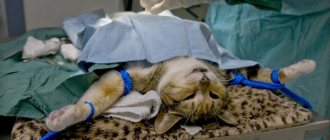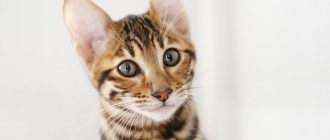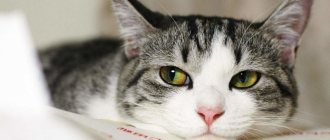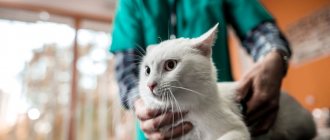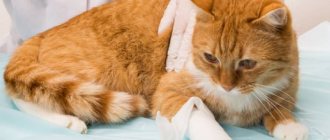8084Administration
Any signs of disease in cats should be investigated, both serious and insignificant at first glance. For example, such as if a cat's nipple is swollen. Because these animals are patient and are ready to put up with the fact that something is going wrong in their body. They only begin to be capricious when the disease takes on serious forms, and nothing can be returned back.
That is why, if you just notice that your cat’s nipple is swollen, sound the alarm: collect information, analyze the cat’s recent behavior, whether there are other signs, perhaps the other nipple is swollen, or ulcers have appeared, etc. Whatever it is, it’s worth noting all this and going with your cat to the veterinary clinic for a detailed examination as soon as possible.
© shutterstock
What could be a sign that the nipple is swollen and red? What actions are needed?
Possible causes of breast swelling and swollen nipples in a cat
New growths of the mammary gland that affect a cat are malignant and benign in nature. In addition, they differ in the characteristics of their growth. Benign tumors under the skin develop slowly, but eventually reach impressive sizes and do not metastasize. A malignant compaction in the area of the mammary glands causes metastasis, the development of necrotic processes, as well as intoxication of the body. Cats with this disease do not live long. Benign pathologies of the organ are mammary hyperplasia. It manifests itself in the following forms:
- Focal;
- Fibroepithelial, cystic.
Moreover, both types develop due to high levels of progesterone in the cat’s blood, which is typical for unsterilized females.
Timely treatment of benign pathologies has a favorable prognosis if it was an unopened cyst or a complicated formation. In this case, there is a significant risk of wound infection. In total, benign tumors are detected in 15% of all pathologies in this organ.
Veterinarians give an extremely cautious prognosis for such a tumor due to the fact that when it reaches a size of more than 3 cm, it is extremely unfavorable. This is due to the frequent development of metastases in other organs, as well as the brain. This disease is also characterized by a high chance of relapse, even if it has already been operated on.
Inflammation can be caused by the penetration of pathogenic microorganisms into the gland; a tumor often indicates the development of mastitis and mastopathy. Hormones have a great influence on the condition of the mammary glands. Hormonal imbalances also often lead to swollen nipples and the appearance of a variety of discharge. Most often, cats develop cancer. The risk of cancer increases in animals aged 10–12 years.
If the glands are swollen, this does not always indicate the presence of pathology. Natural causes of this condition are pregnancy and breastfeeding. Nipple enlargement occurs in the fourth week of pregnancy. This sign is especially well expressed in nulliparous females.
If the female is not pregnant, then most likely the tumor is caused by pathological processes. They can occur as a result of hormonal imbalances, the use of hormone-based drugs, poor ecology, and poor nutrition. The most common breast diseases are:
- neoplasms;
- mastitis (serous, purulent);
- mastopathy;
- false pregnancy.
Forms of mastitis in cats
There are several main forms of mastitis:
- serous;
- catarrhal;
- fibrinous;
- purulent;
- hemorrhagic;
- gangrenous;
- phlegmonous.
Treatment may vary depending on the type of disease.
Serous form
Serous mastitis after sterilization appears in a cat for a number of reasons. The initial degree of pathology can also develop in a female who has undergone a difficult birth. The location of the lesion swells and increases in size, the skin over it becomes dense. Upon palpation, the animal becomes restless, the body feels hot to the touch, especially the affected area and the adjacent areas. The milk that appears when you press on the affected nipple becomes thinner and has an unpleasant putrid odor.
After 3-4 days from the development of the pathology, small flake-like inclusions appear in the milk - particles of the epithelium destroyed by mastitis. The cat's general body temperature rises - this symptom does not always appear. Much depends on the strength of the animal’s immunity and the pathogenicity of the microorganism. Mastitis does not only affect one nipple; as the disease progresses, all milk lobes can be affected.
Catarrhal mastitis
The catarrhal form of mastitis is characterized by damage to glandular tissue. The symptoms are similar to the serous form, but, in addition to the main symptoms, a large number of flakes are formed in the milk, which lead to blockage of the glandular ducts. The milk stagnates, substances that provoke inflammation penetrate into it, and it becomes infected.
In most cases, the cat behaves calmly. The pathology can be asymptomatic; characteristic signs appear after 3-4 days against the background of stagnation of milk and swelling of the mammary glands.
Fibrinous form
Catarrhal mastitis develops into fibrinous mastitis. Complete blockage of the glandular ducts and prolonged presence of milk in them lead to complications. The pathology has a number of features, these include:
- Temperature jumps:
- severe intoxication;
- enlargement of mammary glands and lymph nodes by 2-3 times;
- enlargement and soreness of the nipples;
- presence of crepitus (crunching) sounds upon palpation.
At first, the cat feels normal and does not express anxiety. After a few hours, the animal can already lie motionless. The nipples rapidly increase in size and become denser to the touch. When pressing on the nipples, milk does not appear.
Purulent inflammation of the glands
Purulent mastitis is characterized by a decrease or cessation of lactation. The nipples are enlarged, swollen, and hot to the touch. The skin around the mammary gland is hyperemic. When pressed, the nipple releases pus and blood. The area where the abscess is located is dense to the touch, and upon palpation the animal expresses anxiety. The adjacent tissue has a dough-like consistency. 2-3 days after the development of mastitis, general symptoms join local symptoms.
The animal's body temperature rises and intoxication increases. The female tries to retire, to lie down out of reach of people and kittens instead. In 85% of cases, the pathology becomes chronic: exacerbations occur after childbirth, with hypothermia, or mechanical injuries of the mammary lobes. The abscess does not disappear; it is gradually overgrown with connective tissue. If the size of the purulent body is large, then the mammary gland permanently loses its functional activity and stops producing milk.
Hemorrhagic mastitis
Hemorrhagic mastitis is the most dangerous form of the disease. The blood vessels located inside the ducts of the mammary gland, nipples and alveoli rupture, the tissues become saturated with blood and begin to swell. When touching the mammary lobe and nipples, the cat experiences severe pain.
The general condition is depressed, the animal refuses food and food. Bleeding that develops due to a violation of the integrity of blood vessels can be recognized by the presence of blood on the cat’s fur or brown spots on the bedding.
Gangrenous and phlegmonous types of mastitis
If mastitis in cats is not treated properly, the animal will develop a gangrenous type of mastitis. The milk lobes acquire a dark burgundy or bluish tint. On the gland affected by inflammation, ulcers form that constantly bleed. In rare cases, the cause of the development of a gangrenous form of mastitis can be phlegmon.
The enlarged lesion affects connective and fatty tissues. With the phlegmous type of mastitis, the female’s condition rapidly deteriorates. She is unable to move and often loses consciousness. Body temperature rises to 41-42°C or, conversely, decreases. With the gangrenous or phlegmous type, surgical intervention is required, otherwise the risk of death increases and the animal dies.
Mastitis
Mastitis occurs due to stagnation of breast milk, infection with E. coli or staphylococcus. The disease is accompanied by:
- swelling of the mammary glands;
- increasing them in size;
- redness, cracking skin;
- increased temperature;
- discharge from the chest mixed with pus;
- in some cases - by compactions that can be felt during palpation.
Cats' behavior changes - they become apathetic, lethargic, and their appetite decreases. Touching the mammary glands with your fingers causes severe pain to the animal.
With mastitis, the ducts become inflamed and decrease in diameter, which impedes the flow of milk and leads to its curdling. As a result, the chest hardens, the cat begins to feel feverish, and she looks for a secluded place.
Untreated mastitis is dangerous due to degeneration into a malignant neoplasm and sepsis. Only a veterinarian can accurately diagnose the disease and prescribe the necessary therapy.
At the initial stage, owners can help the pet express milk by lightly pressing and massaging the nipple. This can be done if the animal does not have a fever. To stop lactation, apply a tight bandage to the mammary glands. The amount of fluid consumed by the female will have to be reduced for some time.
Disease prevention
In order to avoid acne on your pet’s nipples, it is necessary to follow preventive measures:
- If you feed your cat natural food, it should be fresh. An animal’s bowl, like its body, is not a garbage can into which waste can be dumped.
- Keep bowls and the area where they are kept clean. Wash them daily and prevent food from drying out and sticking to the bowls.
- The cat's water should be fresh; do not allow mucus to appear in the bowl, especially if it is plastic.
- Change the filler in a timely manner. Remove the used one, add a new one.
- Do not allow your pet to come into contact with homeless or unfamiliar animals.
Types of neoplasms on the chest in cats
Tumors in the mammary glands can be benign or cancerous. Benign formations, such as an adenoma or cyst, can reach impressive sizes. They cause inconvenience to the animal, but do not pose a threat to life.
Malignant tumors often cause death in cats. They can invade areas outside the gland and grow into neighboring organs and tissues. These tumors metastasize, which complicates treatment.
Benign tumors most often arise due to hormonal imbalance caused by the use of hormones or cessation of feeding the offspring. In addition, neoplasms can appear after injury to the mammary glands. Another common cause of cystic glandular lesions is genetic predisposition.
Breast cancer in a cat
The vast majority of tumors in cats are malignant. Breast cancers, such as carcinoma and sarcoma (see photo), grow rapidly and affect other organs. Malignant tumors are difficult to treat because they usually manifest themselves in the later stages of the disease.
Associated symptoms in the presence of pathologies
The onset of a pathological process is indicated not only by the inflammatory process, lumps and discharge. With mastitis, the following symptoms can be observed:
- hot and bright red skin of the areolas;
- animal anxiety;
- soreness when palpated;
- bloody, purulent or cheesy discharge from the nipples;
- change in behavior (apathy, lack of mobility, desire for solitude);
- compulsive licking of the affected area;
- temperature rise to 40 degrees.
The following signs are characteristic of malignant formations:
- clearly defined boundaries;
- hardness and immobility;
- normal skin temperature in the affected area;
- no pain on palpation;
- rapid tumor growth;
- the appearance of ulcers, which may later burst;
- weight loss and loss of appetite;
- the occurrence of metastases.
When a cat is pregnant or breastfeeding, she has a small lump (swelling). A similar situation can be noticed in the case of a false pregnancy. All these phenomena have similar manifestations to tumors, although they are not tumors. But because of this, many owners may already be wondering what to do and how long their pet will live.
Any, even minor, bump in the nipple area should cause concern. Often the pathology is a nodular formation located in the thoracic region. It often affects simultaneously several lobes of the gland, localized in one specific part of the body. Cystic formations may appear.
Adenocarcinoma, being the most common tumor of this organ, has the following manifestations:
- A minor formation that is located under the skin;
- Inflammation of tissue near the tumor;
- Development of ulcers, their bleeding (If they burst);
- Growth of lymph nodes;
- The appearance of pain;
- Fever;
- Development of the necrotic process;
- Significant decrease in appetite.
In the case when a cat has certain seals in the nipple area, the owner needs to immediately show it to the veterinarian to determine their nature. Based on the timeliness of detection of the pathology, as well as its type, not only the treatment depends, but also the possibility of survival of the pet itself.
Features of acne
Does your cat have black spots around his nipples? Try washing them off as we advised above. If it doesn’t work, it’s possible that it’s acne. They can appear not only due to an excess of sebum secreted by certain glands. The reasons for their occurrence look something like this:
- Unsanitary conditions in which the cat is forced to live. Her bowls are never washed, her litter box is cleaned once a week, and her diet consists of leftovers from the master's table? Because of this, the animal’s hormonal levels are disrupted, causing the appearance of black dots near the nipples of a cat or cat.
- Allergy to filler is another factor in acne.
- Contact with a sick animal, oddly enough, will give rise to the fact that your furry pet will develop black spots in the most vulnerable areas of the body.
- When an animal has problems with the central nervous system, various diseases cannot be ruled out. It’s not for nothing that they say that all diseases are caused by nerves. This phrase can also be applied to our smaller brothers. The body reacts sharply to what is happening around it, receiving incorrect information from the environment. More precisely, the information is correct, only the dendrites cannot transmit it along the nerve fibers correctly. And it reaches the brain in a distorted form. He begins to panic, giving various physical reactions, including the appearance of acne on the cat’s body.
- If a pet suffers from diseases of the gastrointestinal tract or liver, it needs a certain diet. Otherwise, food will not be able to be absorbed as it should be, because the gastrointestinal tract cannot cope with its job. The side effects of this factor is the appearance of black spots on the nipples, chin and ears of the pet.
- Regular stress is very difficult for cats to tolerate. The body tries to protect itself from it, and nervous and psychological disruptions occur. The consequences are various mental and physical diseases. Blackheads are one of these consequences.
Mastopathy
Mastopathy is an inflammation of the mammary gland, accompanied by the appearance of cysts and other lumps. A disease without treatment and constant veterinary control can become an impetus for the formation and proliferation of cancer cells.
Mastopathy is more common in individuals who have given birth and is practically not diagnosed in cats that were sterilized at an early age (before a year or a little over a year).
The signs of the pathology are in many ways similar to the symptoms of mastitis:
- the cat's chest is swollen;
- bleeding appeared;
- the glands are visually enlarged;
- touching causes pain to the female.
Timely identified mastopathy responds well to treatment - cats tolerate medications and injections well. The disease at the initial stage is treated with drugs containing iodine and immunomodulators.
In advanced cases, when ulcers appear on the skin, conservative therapy is ineffective. Serious lesions require surgery, during which the affected glands, as well as the uterus and ovaries, are partially or completely removed. The animal will require long-term rehabilitation.
Causes of mastitis
The causes of the disease in females vary depending on the age of the animal and the physiological characteristics of the body. The pathology can develop in a sterilized, nulliparous or parous cat. The main causes include:
- diseases of the reproductive system of infectious etiology during pregnancy or after childbirth;
- hormonal imbalance that occurs against the background of a false pregnancy in the absence of fertilization;
- excess milk that arose against the background of stagnation;
- pathology that appeared during early weaning of kittens from the mother;
- injuries and bruises of a mechanical nature;
- sepsis, caused by the entry of fungi and other pathogenic microorganisms into the mammary glands through cracks in the nipples;
- hypothermia of the whole body or mammary glands;
- development of complications in the period after childbirth;
- inflammation of the suture after sterilization.
It is recommended to periodically inspect the milk lobes of females for cracks in the nipples. If there are injuries to the glands, wound healing compounds must be applied to them, which are purchased in specialized pharmacies after consultation with a veterinarian.
In a nulliparous cat
Mastitis in a nulliparous cat most often develops against the background of a false pregnancy. Hormonal disruptions occur during “empty” estrus, if ovulation has not occurred. The physiological causes of false pregnancy include swelling of the nipples - when you press on them, colostrum appears. If there are no newborn kittens and there is no one to suckle milk, the cat develops a serous form of the disease.
The female's temperature fluctuates, the animal loses its appetite. To prevent the development of other forms of the disease, it is necessary to take your cat to the veterinarian. An ultrasound specialist will refute or confirm the diagnosis and, if necessary, prescribe medication. To stop lactation, the female is given sedative medications.
After sterilization
Swelling of the milk lobes in a sterilized cat is characterized as a complication. During surgery, the veterinarian removes only the uterus, leaving the ovaries. In this case, the risk of mastopathy increases - fertilization of the female is impossible, but the ovaries continue to work as usual and produce hormones. The process affects the hormonal status, the animal’s body is in a stressful situation.
The suture after sterilization is located on the stomach. Lack of normal care and timely treatment of the suture increases the risk of developing inflammatory processes inside the scar. Infection in tissue can occur in several ways:
- Failure to comply with asepsis rules. During the rehabilitation period, the animal must be moved to a separate room. Bedding needs to be changed regularly; experts recommend using sterile disposable diapers for this purpose.
- Excessive cat activity. A female who constantly tries to lick and scratch the seam can cause an infection. In order to protect the cat, you need to put a special collar on it.
If the female has inflammation before sterilization, the risk of mastopathy increases.
After weaning kittens
If the kittens died immediately after birth or the cubs are severely weakened and are unable to suck milk on their own, the female’s mammary glands swell due to stagnation of milk. Lactostasis is accompanied by severe pain; the animal does not allow the owner to touch the nipples. In the absence of timely treatment, the milk lobes swell and acquire a bluish tint.
If milk does not come out naturally, then you need to purchase a special device - a breast pump. It can be used at the initial stage of the pathology - with a purulent, hemorrhagic or fibrous type, a breast pump will no longer help.
Diagnostics
To differentiate the form, as well as the type of pathology, the treating veterinarian, in addition to examination and palpation, based on the need, prescribes the following diagnostic measures:
- Blood analysis. Often these are general and biochemical. They allow you to assess the pet’s condition and, if there are other pathologies, identify them;
- Ultrasound and chest x-ray. With their help, the exact localization of the main tumor is revealed, as well as the presence of metastases and from the location;
- Biopsy, or fine-needle aspiration of pathological tissues and lymph nodes for cytological examination;
A histological examination of biopsied tissues can also be used to identify the exact type of formation that affects the cat. Due to this, the appropriate treatment for the tumors is selected.
Diagnostic methods
What to do if your cat has a swollen nipple? First of all, the animal is examined by a specialist. Next, the cat's blood and the substance discharged from the chest are taken for analysis. Bacteriological examination of mammary gland secretions allows us to identify the causative agent of the disease. Cytological analysis of the fluid shows the degree of development of mastitis or another disease.
Ultrasound is a universal research method for both mastitis and tumors. Using ultrasound, the affected area and the size of the compaction are determined, as well as the presence of contents in the gland ducts.
To find out the nature of the compaction, a biopsy is performed. Cells from lymph nodes located in the affected area are also taken for analysis. It is possible to clarify the presence of metastases in malignant neoplasms using the X-ray method.
Symptom
Cats have four pairs of nipples on the anterior abdominal wall. Most often, pathology develops in the last two pairs of nipples. One nipple (rarely several) increases in size. Along with the nipple, the mammary gland also swells. What diseases can this occur in?
Therapy
Treatment for hard mammary glands in a nursing cat depends only on what causes these lumps. For diseases such as mastopathy and cancer, a qualified veterinarian prescribes conservative therapy or surgical treatment. In the first case, the animal takes medications aimed at stabilizing hormonal levels and vitamins. In the second case, surgical intervention is performed, during which the mammary gland and nipple are removed. Subsequently, they are sent for laboratory testing.
In some cases, there are indications that do not allow surgery. The reason for refusal may be a weak heart. Then there is another way - chemotherapy. This method is also quite serious; it is prescribed when the purr has a strong liver and kidneys. Chemotherapy for cats is carried out using the following drugs:
All final decisions are made after a detailed study of all influencing factors. The opinion of experts depends on:
- stage and type of cancer;
- tumor localization;
- general health of the animal;
- material capabilities of the owners.
Radiation therapy has become an analogue of radiation therapy. This procedure is used not only to eliminate cancer cells, but also to neutralize their consequences. Ionized radiation, entering the body, prevents cancer relapses. Based on the type of beam, this therapy is divided into x-ray therapy and gamma therapy.
Treatment
Once a pet has been given a disappointing diagnosis of a tumor, removing the cat’s mammary tumor is often the only way to save his life. If the pathology is benign, then after removal surgery there will be an almost complete recovery. But it is important to do this before inflammation or ulceration begins.
In cases where surgical treatment is not possible for certain reasons, conservative methods are used. Thus, for benign pathologies, the essence of such therapy will be to stop the growth and development of the pathology, as well as to prevent infection of the abnormal tissues. In addition, it is necessary to increase the animal’s immunity level.
For this purpose, various antitumor and antibacterial agents are used. This could be Dokosorubicin. Also, if there is cancer in a pet, Cyclophosphamide is used, which has a cytostatic effect. Non-steroidal anti-inflammatory drugs are also prescribed, which include Meroxicam, and painkillers and antibiotics are used.
When adenocarcinomas are detected, they are surgically removed. In this case, resection of pathological tissues is carried out, along with all tissues of the organ, to prevent metastasis. The procedure consists of several stages, due to the fact that a complete mastectomy when performed in one stage is extremely difficult for animals to tolerate.
The course of treatment for the cat is prescribed depending on the results of the tumor examination. The benign lump is excised, after which the animal makes a full recovery. The cancerous lesion will also have to be removed to save the pet’s life. However, in this case, additional therapy is usually required after surgery to reduce the likelihood of relapse.
Mastitis in a cat can be cured with ointments, injections and tablets. As a rule, veterinarians prescribe Gamavit or Catozal, a solution of calcium gluconate. Injections of Travmatin and Mastometrin are used both for the treatment and prevention of mastitis. The duration of the course and dosage are determined by the doctor, taking into account the pet’s weight and other conditions.
In severe cases of purulent mastitis, antibiotics are prescribed. If there is a significant increase in body temperature, the animal is given an injection of analgin with diphenhydramine. When pus flows from the nipples or they bleed, it is necessary to treat with Chlorhexidine or hydrogen peroxide. If your nipples are inflamed, it is recommended to smear them with products that have a wound-healing and analgesic effect. The condition of swollen glands can be normalized with the help of ointments (Mastiet Forte, Gamabiol, Iruksovetin, Levomekol, Trauma-gel).
Surgery is the main way to combat malignant tumors. The veterinarian prescribes surgery after assessing the size of the lesion and the condition of the cat. Depending on the degree of growth of pathological tissue, one or more mammary glands are removed. In case of bilateral pathology, 2 operations are performed with an interval of 14 days. However, when cancer cells penetrate the skin, the affected area on the abdomen is completely removed in one operation.
Doctors usually recommend removing lymph nodes to reduce the risk of cancer cells growing back. In some cases, it is also necessary to remove the ovaries and uterus.
Chemotherapy is used in the treatment of cancer in animals. It is usually carried out to prevent relapses. Cats are given such strong drugs as Doxorubicin and Cyclophosphamide. These drugs can completely stop the development of tumor processes. However, these medications have many side effects and lead to severe intoxication. Pets can only be treated with these drugs under the close supervision of a specialist.
In some cases, it is impossible to operate on a cat due to its age or concomitant chronic diseases. In this case, chemotherapy becomes the only way to stop the growth of the tumor and prolong the life of the pet.
Sometimes surgery is refused because the size of the lump is too small. In such situations, chemotherapy can give excellent results and lead to a complete recovery of the cat.
Folk remedies
Folk remedies are used, as a rule, in the treatment of mild forms of mastitis. Warm compresses with herbal infusions have a positive effect. For lotions, decoctions of oak bark, sage and chamomile are prepared. It is very important that the infusion is not hot. Excessive heating of the affected area can make the situation worse.
Damaged nipples can be gently massaged with camphor or ichthyol oil. After this, a bandage should be applied to the lubricated areas for a short time to prevent the animal from licking the oil.
With malignant tumors, the cat may experience severe pain. In this case, the use of folk remedies as additional therapy is allowed. Decoctions of herbs such as calendula, spurge, arnica, wild rosemary and knotweed will help slow down abnormal cell growth and reduce pain.
For benign formations, decoctions of burdock, cinquefoil, plantain, tartar, fireweed will contribute to a stable improvement in the pet’s condition. For cancerous tumors, these herbs will help contain the development of metastases.
How to treat?
Attention! This section is for informational purposes only. Treatment can only be prescribed by a veterinarian; we provide this information so that the owner knows what is ahead of him and can calculate the approximate costs of the drugs.
In the case of the primary manifestation of the disease, “light” medications are used. The main emphasis is on treating the affected areas of the body with products that include chlorhexidine. By the way, it can be purchased in its pure form. The drug is called: chlorhexidine solution.
Take a cotton pad, soak it in the solution and carefully treat the black spots on your pet’s nipples. Then wipe with a dry cotton swab, removing any remaining liquid, and cauterize with iodine.
Your veterinarian may prescribe an ointment. As a rule, this is “Vedinol”, which has proven itself in veterinary medicine as an anti-inflammatory agent. The drug also promotes rapid wound healing very well. Before applying the ointment to damaged areas of the cat's body, it is necessary to treat them with chlorhexidine.
An alternative to Vedinol are ordinary human ointments, which include Sintomycin and Flucinar.
For secondary acne, antibiotics are used for external use. They are prescribed only by a veterinarian, sometimes he recommends oral medications.
When the rash has not yet become inflamed, this stage of the disease is considered the initial stage. No medications are needed here, just a cosmetic lotion to remove makeup is enough. You need to choose one that has disinfectant properties.
What to do
The first thing to do is to carefully examine the nipple yourself. To understand the nature of the disease, whether there is a tumor under the nipple and to see the cat’s reaction.
The next step is to take your pet to a doctor for examination . Only a specialist can accurately determine the cause of the tumor and decide what needs to be done. It may be necessary to remove breast tumors surgically if the cancer is in its early stages. Or, if it is mastitis, and the tumor is the remains of milk. You will need to take a course of antibiotics. In any case, both diagnosis and treatment are prescribed only by a veterinarian
Caring for your cat after surgery
The result of treatment depends not only on timely surgery. Surgical removal of the tumor is only the initial stage of the fight against cancer. Postoperative care plays an important role. A pet who has undergone surgery must be provided with complete rest. In addition, you must follow your veterinarian's instructions and follow all recommendations regarding your cat's diet.
The seam must be regularly treated with a special product, which is also prescribed by the veterinarian. In addition, the animal must be given a number of medications, strictly observing the time of administration and dosage. This will help avoid complications.
For some time after removal of the tumor, the cat must wear a special blanket. It is designed to protect the seam and prevent inflammation. The owner must carefully ensure that the blanket is held securely and does not come undone.
Scheduled inspections are carried out weekly. To assess the animal’s condition and understand how its recovery process is going, the veterinarian will take the necessary tests. However, even the most experienced doctor cannot say exactly how long a cat will live after surgery.
Causes
Before you grab your cat and run with it to the veterinary clinic, you need to find out what could trigger the appearance of black spots on and around the animal's nipples. There may be several reasons, and we will consider each of them in detail:
- Banal pollution.
- Pregnancy.
- Increased activity of the sebaceous glands.
Let's start our conversation by considering the first reason.
Preventive measures
Owners of domestic cats should carefully monitor the condition of their pet's nipples, since tumors in them are most often malignant. If even small balls appear under the skin, it is necessary to urgently show the animal to a veterinarian. To protect your pet from this terrible diagnosis, you need to follow the recommendations of specialists:
- Sterilize a nulliparous female before puberty. Many scientific studies have shown that spayed females have a reduced risk of developing malignant tumors on the mammary glands.
- Do not use hormonal contraceptives. During the period of female heat, people usually use veterinary drugs that neutralize its symptoms. These medications contain hormonal substances that disrupt the activity of the animal’s own gonads.
- Use quality feed. Cheap food with a large number of additives and carcinogens is one of the reasons for the development of cancer in animals.
If the nipple is swollen due to mastitis or mastopathy, then the prognosis in this case will be favorable. However, mastitis also causes a lot of trouble for the animal, so it is better to try to prevent it. Prevention of this disease includes the following measures:
- regular antiparasitic treatment;
- eliminating the possibility of your pet getting injured and hypothermia;
- preventing stagnation of milk in the breast of a nursing female, applying kittens to all nipples;
- frequent change of bedding for a female with kittens;
- trimming babies' claws if they damage the skin on the mother's chest;
- the use of special ointments for cracks in the areolas and nipples.
Prevention
It is important to know not only how to treat mastitis in a cat, but also how to prevent it. Below we have prepared a list of useful tips for you in this case:
| Monitoring your cat's fluid intake | If there are few kittens, then limit the amount of liquid you drink for the cat who has given birth. |
| "Manicure" for kittens. | Also, be sure to trim your kids' nails. They can scratch their mother's nipples while sucking. This will cause bacteria to enter the cat's mammary glands. |
| Diet of a pregnant and lactating cat | Be sure to discuss the diet of your pregnant and lactating cat with an experienced veterinarian. Some types of food (cottage cheese, mineral or vitamin supplements, etc.) stimulate milk production. |
| Maintain animal hygiene | Dirty bedding, floors, and tray can lead to bacterial contamination of the nipples. If necessary, wash the skin with a decoction of oak bark, a very weak solution of potassium permanganate (literally a crystal in half a liter of water). If you notice cracks, be sure to lubricate them with cream. |
| Avoid injury | Place the pet's bed away from drafts. |
| Deworming, preventative treatment against fleas and ticks | Carry out deworming in a timely manner (parasites greatly weaken the immune system). Don't forget about ticks and fleas. They not only reduce the body's defenses, but also cause itching. As a result, the cat scratches itself, thereby opening the “gate” for pathogenic bacteria. |
Pollution
On cat lovers' forums there are often questions about black spots on the nipples of pets. These points appear regardless of the sex of the animal and its age. Owners react differently: some panic and ask what to do, some ask absolutely calmly what these points are, and others immediately move on to the question of whether this is fatal for the cat.
More experienced owners, judging by the number of emoticons, slightly laugh at such alarmists. And they advise you to wet a cotton pad with warm water or skin tonic, gently wipe your nipples or the area adjacent to them and admire the results of your labors. A few black dots on a cat's nipple are not a reason to bury your pet prematurely. This may be the most ordinary, most banal contamination, easily removed using the method described above.

